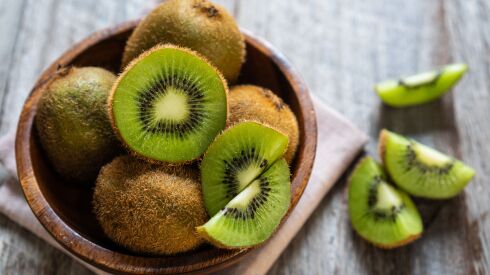
Similar in texture to strawberries, kiwis have their own unique, almost tropical, sweet flavor.
stock.adobe.com
Rather homely looking, the kiwifruit is proof that beauty is on the inside.
Kiwi’s vibrant green flesh has been coveted since it was discovered in its native China. New Zealand growers exported what was known as the Chinese gooseberry around the world. It didn’t come to be called kiwifruit until the 1960s, when a California produce dealer thought it resembled New Zealand’s national bird, the fuzzy brown kiwi. Today, California grows 98% of the U.S. supply of this unique and nutritious fruit.
There are more than 40 varieties of kiwi, including the golden kiwifruit, but the most common is the Hayward. These brown, fuzzy-skinned ovals hide an emerald flesh accented with artistic rings of tiny, black, edible seeds. Similar in texture to strawberries, kiwis have their own unique, almost tropical, sweet flavor.
Though small, kiwis are big on nutrition. A one-cup serving has more than two and a half times the daily value of antioxidant vitamin C — more than the same amount of orange and more potassium than a banana.
Growing evidence links kiwifruit to digestive health benefits due to its bioactive components, including soluble and insoluble dietary fiber and several plant compounds associated with improved digestion.
One study found that healthy participants and those with irritable bowel syndrome who ate three kiwifruits daily increased bowel frequency and reduced constipation.
According to a review of studies, kiwi can be part of a natural and effective dietary strategy to tackle some of the major health and wellness concerns around the world, including digestive, immune and metabolic health.
California kiwifruit are harvested from October through May, which complements New Zealand’s June-October season, meaning fresh kiwi is available year-round.
Choose firm, unblemished fruit. They’re ready to eat when they give to slight pressure. Ripen on the counter for a day or so, where they’ll keep for several days, and up to four weeks refrigerated.
Enjoy kiwi sliced or scooped with a spoon from two halves, tossed in salads, added to fruit tarts or as a garnish for drinks and desserts.
Environmental Nutrition is an independent newsletter written by experts on health and nutrition.
from Chicago Sun-Times - All https://ift.tt/6e7wusP

No comments:
Post a Comment